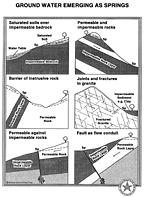
Groundwater that flows naturally from the ground at the surface is called a spring; where the flow is diffused, it may be called a seep or seepage. Many rivers receive water from diffuse seepage. The occurrence of most springs is controlled by the structure of the rock formations. The flow rate from a spring may depend on groundwater recharge conditions, the season and the water demands of vegetation. Typical geological situations (very simplified) for the occurrence of springs are shown in the five cross sections:
Saturated Soils Over Impermeable Bedrock A spring can occur if impermeable bedrock prevents downward flow. The size of upslope area, the soil thickness and the frequency of precipitation (rain or snow-melt) will determine whether the spring flows year-round.
Permeable and Impermeable Rock Formations Where rock strata have been tilted and eroded, it is possible for precipitation falling on one side of a hill to contribute to spring or seepage flow on the other side. Finding the origin of recharge to a spring can be important if the source is to be protected.
Barrier of Intrusive Rock A spring may result from the occurrence of impermeable intrusive volcanic rocks. In this case, water emerges as a spring, flows as a stream where the rock is impermeable, and then seeps below the surface when it reaches permeable rock, before seeping into a stream in the valley.
Joints and Fractures In igneous rocks such as granites, water moves through weathered zones, joints and fractures. A spring can occur when an impermeable layer causes water to reach the surface.
Geologic Fault as Conduit In situations where rocks are fractured along the line of a geologic fault, it may result in a spring supplied from an aquifer in contact with the fault. Depending on the topography of the land surface, there could be a line of springs related to the same fault.
Springs have provided sources of drinking water for humans for millennia. Some springs flow constantly at rates of hundreds of gallons per minute; many more flow at just a few gallons a minute. Once groundwater flows as a spring, it looses the natural protection provided by the overlying rock layers and is more vulnerable to contamination threats from surface and atmospheric conditions. Many homes, farms and cabins use spring water as a drinking source by constructing a protective hut, or "spring-box," that keeps critters out of the source water. However, compared with water from drilled wells, there is a greater risk of bacteria or protozoa occurring in springs, and some form of disinfection (a UV system, for example) in addition to regular water quality testing, is recommended.
These diagrams were originally published in The American Well Owner, 2000, #3. More photographs of springs and other natural water landscapes may be found at www.geo.duke.edu/geo41/gw1.htm.
Visit the American Ground Water Trust's Web site at www.agwt.org. Next month's education article will discuss aquifers: they contain groundwater, but not all groundwater is found in aquifers.


Report Abusive Comment